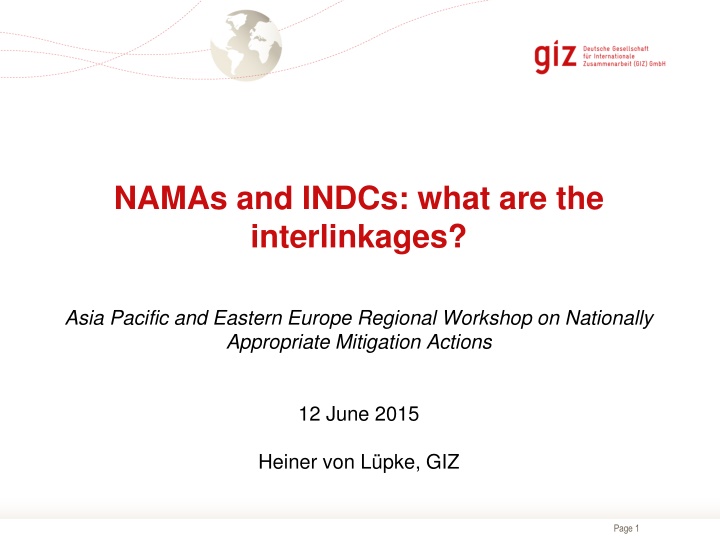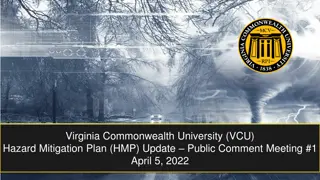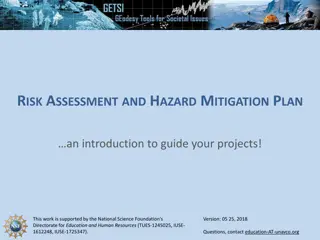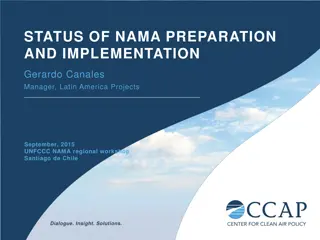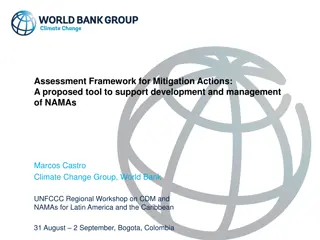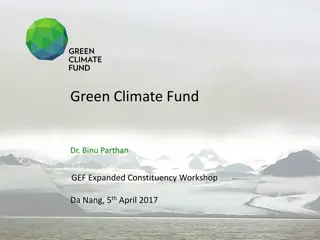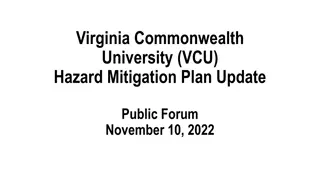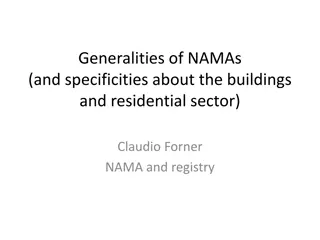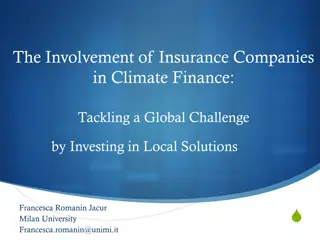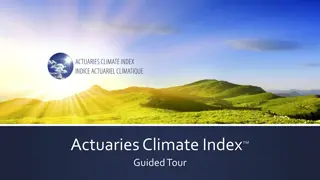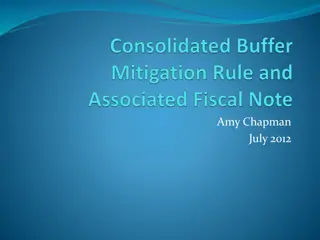Interlinkages Between NAMAs and INDCs in Climate Mitigation
Both NAMAs and INDCs are key concepts in climate mitigation efforts, yet their connection and implementation require further clarification and coordination. This article discusses the challenges, opportunities, and examples of NAMA-INDC linkages to promote a coherent mitigation strategy in the post-2020 era within the UNFCCC framework.
Download Presentation

Please find below an Image/Link to download the presentation.
The content on the website is provided AS IS for your information and personal use only. It may not be sold, licensed, or shared on other websites without obtaining consent from the author.If you encounter any issues during the download, it is possible that the publisher has removed the file from their server.
You are allowed to download the files provided on this website for personal or commercial use, subject to the condition that they are used lawfully. All files are the property of their respective owners.
The content on the website is provided AS IS for your information and personal use only. It may not be sold, licensed, or shared on other websites without obtaining consent from the author.
E N D
Presentation Transcript
NAMAs and INDCs: what are the interlinkages? Asia Pacific and Eastern Europe Regional Workshop on Nationally Appropriate Mitigation Actions 12 June 2015 Heiner von L pke, GIZ Page 1
Content Background: Why dealing with NAMA-INDC interlinkages? State of play: State of NAMAs State of INDCs Example of possible NAMA-INDC linkages Conclusions 18.02.2025 Page 2
Background: Why dealing with NAMA - INDC connections? Both INDCs and NAMAs are mitigation concepts, but rather loosely defined, clarification is needed as a foundation for implementation; Confusion around new acronym INDC ( is that yet another mechanism? ), lack of understanding how it links to NAMAs; NAMAs are currently developed and implemented, INDCs are in the start up phase for post-2020: How to bring them together in a coherent mitigation strategy? 18.02.2025 Page 3
UNFCCC process: Run up to COP 21 and a global agreement Copenhagen 2009 Warsaw 2013 Bali 2007 Durban 2011 Lima 2014 Paris 2015 COP 15 COP 17 COP 19 COP 20 COP 21 COP 13 Global agreement 2020?? No follow up to Kyoto protocol, turnaround of process Lima call for climate action draft text for COP 21 Intended nationally determined contributions (INDCs) NAMAs, MRV, REDD+ Durban platform to negotiate a global, binding agreement Warsaw REDD+ decisions 18.02.2025 Page 4
Timeline: pre-2020 and post-2020 in the UNFCCC Pre 2020: top-down emission reduction commitments for developed countries; bottom- up individual country emission reduction targets, NAMAs, REDD+, MRV, but no binding global agreement applicable to all Parties COP 21: expected global climate change agreement (to enter into force 2020), applicable to all Parties, with INDCs at its core 18.02.2025 Page 5
Background: Status of NAMAs Source: NAMA Status Report May 2015, Mitigation Momentum (2015) Internationally largely undefined, but different types of NAMAs emerge as they are implemented; UNFCCC NAMA Registry contains 57 NAMAs: 21 seeking support for preparation and 36 seeking support for implementation; Most NAMAs in registry seek support, but shadow figure likely high of unilateral NAMAs; NAMAs spread across all sectors and continents, can be projects, policies or strategies. 18/02/2025 Page 6
What are Intended Nationally Determined Contributions? INDCs are contributions by all parties to the UNFCCC to reduce GHG emissions for the global agreement on climate change post 2020 period Based on the understanding that further ambitious emission cuts are needed to stay below 2 degrees global warming INDCs should present a progression beyond current mitigation efforts ( no backsliding ) More clarity on the information to be provided with the INDC Secretariat publishes INDCs on UNFCCC website and will prepare a synthesis report on the aggregate effects of INDCs communicated by 1 October 2015 18.02.2025 Page 7
INDC submitted to UNFCCC Norway European Union Switzerland Canada Andorra Russia Liechtenstein USA Morocco Mexico Ethiopia Gabon Page 8
Submissions till date (10th June 2015) Switzerland European Union 03. March Norway Mexico U.S. of America 31. March Gabon Russia Liechtenstein Andorra Canada Morocco Ethiopia 27. February 27. March 30. March 01. April 01. April 24. April 30. April 15. May 05. June 10. June INDC portal by UNFCCC: http://www4.unfccc.int/submissions/indc/Submission%20Pages/submissions.aspx 18/02/2025 Page 9 Support for preparations of NDCs
and information they typically contain: Country background INDC type (absolute target against base year, target relative to a business as usual scenario) Base year, period, baseline scenario GHG emission reduction level Scope (sectors and GHG types) Adaptation aspects Planning process Information on why the INDC is fair and ambitious Source: UNFCCC (2015): INDCs as communicated by Parties 18/02/2025 Page 10 Support for preparations of NDCs
what does it take to develop an energy efficiency policy / measure into a NAMA and INDC? INDC + An upscaled EE project / program + MRV system + NAMA support policies Mitigation Ambition level An upscaled EE project / program + MRV system + NAMA support policies An upscaled EE project / program + initial NAMA projects and MRV An upscaled EE project / program An EE project / program Enhanced Energy Efficiency + mitigation Page 1 Existing program, no climate policy Intervention of climate policy (NAMAs) Increased importance of climate policy Page 11
Some observations regarding the transition of NAMAs to INDCs Much technical work, readiness and capacity enhancement (concept) is being done for the NAMAs valuable base for INDCs; Climate policy framework still emerging in the NAMA context, however strong policies are needed for: Budgeting; Implementing & monitoring mitigation actions in a unilateral way which is precondition for the INDCs (overarching framework needed to involve stakeholders); NAMAs need to be up scaled from project to wider level of programs / sectors in order to deliver impacts of sufficient scale Are conditional INDCs by developing countries similar to supported NAMAs? 18/02/2025 Page 12 Type presentation title here
INDCs INDC policy targets: Political leadership Policy targets (e.g., +30 % renewables in energy mix) Policy instruments (e.g., FIT, carbon standards) Policy enforcement NAMAs current stage NAMA projects: IRR Technical feasibility Legal conditions Social-environmental, MRV / GHG impact assessment INDC NAMAs (post-2020) Example: Combining project based NAMAs with an INDC policy target 18/02/2025 Page 13 Type presentation title here
Conclusions Strong need to bring together NAMAs and INDCs and see the big picture: Countries need long-term, coherent mitigation strategies and action programs To generate momentum for implementation of NAMAs, clear policy signals from strong INDCs are much needed In turn, NAMA implementation can inform about successes and results to those negotiating and developing INDCs It will be worthwhile to look into the technicalities of linking up NAMAs and INDCs (e.g., harmonize metrics, time periods, assumptions and methods used), that way, NAMAs and INDCs can built conductively on each other With all the similarities and need for integration of NAMAs & INDCs, one thing is different: INDCs should show a progression to what countries are doing currently, aka, raising the ambition level 18/02/2025 Page 14 Type presentation title here
Thank you! Contact: heiner.luepke@giz.de 18/02/2025 Page 15 Type presentation title here
